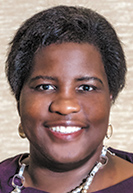Subscriber Benefit
As a subscriber you can listen to articles at work, in the car, or while you work out. Subscribe NowCrystal Miller knows it’s a daunting challenge to cold-call potential donors and ask them to write a check to help improve food insecurity, social isolation and other health challenges around Indiana.
But it’s a different story if she can get them to pay a visit to her studio on the eighth floor of Methodist Tower.
The large room in the office tower at North Capitol Avenue and West 16th Street is decked out with elaborate models of Indiana University Health’s $4 billion construction project on the northern edge of downtown, where some of those programs will take place. The view from the windows shows a flurry of construction activity on the expanded Methodist Hospital campus.
“Having an opportunity to see and almost touch and feel the vision that we have is a better experience,” said Miller, president of the IU Health Foundation, which is in the midst of a $200 million capital campaign to help Hoosiers avoid and treat illness and improve social and economic factors that boost health.
“It’s different from an old fundraising event where you might simply show up for something and buy a ticket,” she added. “We are trying to respond to what our donors are looking for.”
The campaign has already raised more than $136 million, including more than $35 million from individual donors. Some of that giving occurred after Miller and her team led more than 100 people through the studio and let them see what the fundraising campaign was all about.
Getting people to visit an institution, get a hands-on understanding of the mission and start a relationship is emerging as a trend in giving, according to national surveys and experts in the field.
And around Indiana, many organizations that rely on philanthropic dollars to operate are taking steps to connect with donors in a more meaningful way than the traditional campaign kickoffs, cold calls and mass mailings.
The strategy seems to be paying off. Last year, universities, hospitals, museums, theaters, dance companies and other not-for-profits in Indiana pulled in a total of $348.7 million from 79 gifts of $1 million or more from individuals, family foundations and bequests, according to IBJ’s latest survey.
That’s a 45% increase from 2022, when organizations pulled in $241 million from 54 large givers. The survey does not include gifts from corporations, large foundations or government agencies.

Building relationships
Across Indiana, hundreds of not-for-profits count on individual gifts for a significant portion of their revenue. And to land the big gifts, institutions are increasingly turning to hands-on, in-person events in the hopes of building long-term relationships.
Purdue University, which landed $129.3 million, including six of the 10 largest gifts, largely shuns the old-school model of university-wide campaign kickoffs, which can cost tens of thousands of dollars.
“I don’t believe in wasting all the marketing dollars for a big, general, university-wide campaign,” said Matt Folk, president of the Purdue for Life Foundation, the university office that handles all advancement, alumni and fundraising efforts. “I would rather work with individual donors and meet them where their interests are and help develop programs that have mutual interest with the university.”
That means inviting successful graduates to help teach a class for a semester or just visit for a few days to connect with students, give them advice and help mentor them. It also means bringing alumni together for sporting events, tailgate parties, mixers and other get-togethers.
The goal is to build stronger relationships. Most, if not all, not-for-profits want steady donors who feel a close connection to the institution and will stick by an institution through the up-and-down cycles of the economy.
It’s a tough time to raise money. Americans gave just 1.7% of their disposable income to charity in 2022, the lowest percentage since 1995, according to Giving USA’s annual report, researched and written by the Indiana University Lilly Family School of Philanthropy at IUPUI.
Giving by individuals—which accounts for more than 60% of all charitable giving—dropped 6.4%, the report said. Overall giving (including by corporations and foundations) declined 10.5%, after adjusting for inflation.
“Conditions [in 2022] were considered a ‘perfect storm’ for a decline in individual giving,” the report said. “The market decline likely affected major donors, disposable personal income declined for everyday individual donors, and inflation and interest rates were incredibly high across the board.”
In addition, current donors are getting older. Baby boomers are aging at a fast clip—joining Medicare at a pace of 10,000 a day, a rate that will continue until 2030. In the process, many are retiring and giving up big incomes.
Yet not-for-profits rely disproportionately on boomers, who gave an average of $2,568 per household in 2022—far more than any other generation, including Gen X ($1,220), millennials ($1,323) and Gen Z ($747), according to Giving Institute figures.
In light of that, Indiana’s numbers seem to be bucking a national trend, with the number and total amount of individual gifts up every year the past four years, according to IBJ’s non-scientific survey of universities, hospitals and other not-for-profits.
Some philanthropic experts call that heartening.

“It’s encouraging to see that, in Indiana, the number of donors at that very large level is going up,” said Amir Pasic, dean of the IU School of Philanthropy. “I think that’s very positive for Indiana.”
In contrast, he said, the share of Americans who donate to charity has been slipping steadily in recent decades. In 2002, 68% of households made charitable donations, but that number fell to 50% in 2018, the last year for which figures are available, according to the Lilly School’s Philanthropy Panel Study, which is billed as the largest, most comprehensive study of charitable giving by U.S. households.
Until 2022, the total giving by individuals had been rising for many years, forcing many not-for-profits to rely on fewer donors for more dollars.
“Typically, we’ve been saying, ‘Dollars up, donors down,’” Pasic said. “That has been a broad phenomenon, and many nonprofits will tell you that even when their giving goes up, it’s coming from a smaller number of donors at the top level.”
He added: “And so I think more nonprofits are worried about that … because typically you have a kind of a fundraising operation where tomorrow’s big donors are today’s small donors. And today’s small donors are diminishing.”
Taxing changes
Some fundraising consultants say the race for gifts is becoming harder and harder.
“With a flooded philanthropic marketplace, fewer numbers of donors giving to charity and shrinking donation sizes at all donor segments, competition for the donor dollar is fierce, creating space for innovative and entrepreneurial marketing strategies,” said BWF, a philanthropic consulting group based in Minneapolis, in a recent report.
Another major factor: The U.S. tax-filing system is not rewarding charitable giving as it once did. In 2017, the federal government expanded the standard deduction so that far fewer taxpayers itemize these deductions on Schedule A.
As a result, the number of taxpayers itemizing charitable donations dropped to 12 million in 2021 from 37 million in 2017, according to data from the Internal Revenue Service. During the pandemic, Congress temporarily expanded tax deductions for very large and very small charitable donations, but these changes expired at the end of 2021, according to The Wall Street Journal.

Claudia Cummings, president of the Indiana Philanthropy Alliance, a not-for-profit industry network, said the tax change has helped lead to fewer people making giving a priority.
“We believe that that is due in part to the destabilization of the universal charitable tax deduction,” she said. “We had that as a staple in our tax code for years. And then it was taken out. … And we believe that lower-dollar givers are not participating like they have in the past.”
Some not-for-profit advocates and public officials are pushing to reinstate the universal charitable deduction. Earlier this year, a bipartisan group in Congress introduced “The Charitable Act,” which would raise the previous cap on the non-itemizer deduction to one-third of the standard deduction, equal to roughly $4,500 for individuals and $9,000 for joint filers, according to the NonProfitTimes, an industry newsletter.
“This legislation, which will broaden the base of charitable donors, is vital toward achieving a vibrant charitable sector beneficial to the entire nation,” Shannon McCracken, CEO of Washington, D.C.-based Nonprofit Alliance, said in a statement.
Anonymous giving
One big change in giving in Indiana has been the increasing numbers of donors who don’t want their names released. Last year, more than one-third of all gifts of $1 million or more (27 of 79 gifts) were made anonymously, representing $79 million.
It included a $20 million anonymous gift to Taylor University, the fourth-largest gift from an individual in Indiana last year. The gift is designated to match all other gifts over $10 that are made to a scholarship fund.
“I think some people have different levels of privacy that they desire,” said Mike Falder, vice president at Taylor, a private, Christian university based in Grant County. “We’re not willing to push people to be able to use their name. So we just kind of leave it there. That’s their wish.”
The number of anonymous million-dollar givers is up from just seven in 2020, one in 2021 and 10 in 2022.
That could be due in part to a new Indiana law that gave another layer of privacy to donors. The law prohibited any government agency from requiring a not-for-profit to hand over information that would identify members, supporters, volunteers or donors.
Supporters of the law said it would help donors keep unwanted solicitors at bay. Critics have said public disclosure is important to provide accountability and prevent fraud.
Overall, the vast majority of the large gifts in Indiana, including nine of the top 10, were given to colleges and universities. The big gifts come as public funding for many public universities has decreased in recent years.
Thirty-two states spent less on public colleges and universities in 2020 than in 2008, according to a report from the National Education Association.

Generational giving
Lower giving is especially true for younger donors (Gen X and beyond), who are writing smaller checks and require not-for-profits to practice more patience to develop relationships that pay off.
At IU Health Foundation, officials said part of their strategy is to adjust to the shift in generational giving.
They pointed out that even millennials—who surpassed baby boomers in 2022 as the largest generation in the United States, with an estimated population of 72.24 million—are showing signs of increased giving. But boomer households still give nearly twice as much.
“Millennials gave 40% more in that 2022 report than they had in 2016,” said Miller, the IU Health Foundation’s president. “And health care increased for them over 400%. And so we are seeing a shift in the data around where donor groups are placing priority.”
At her eighth-floor studio, Miller can invite potential donors to see the footprint of the hospital project, examine samples of the building materials and see detailed models of the buildings and green space.
The hospital expansion, projected to wrap up in late 2027, is one of the most expensive construction projects in Indiana. It’s being funded by IU Health cash reserves and debt, while the health and equity programs that will take place inside the hospital and at various sites around Indiana are being funded by the foundation’s “All the Difference” capital campaign.
Miller said her goal is to develop long-term relationships, which might take years but could pay off handsomely down the road.
“We know that as some of our younger generations seek to engage, it is less transactional,” Miller said. “… We know for a lot of individuals, we are bringing them into the studio as a first conversation.”•
Please enable JavaScript to view this content.

“Not for Profit.”